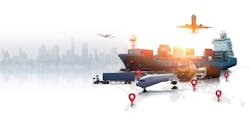Dipping into supply chain digitalization vs. taking the plunge: A Q&A with Uptake's Kayne Grau
Sounds simple enough, right? Maybe. Here we connect with Kayne to learn more…
Smart Industry: What do you mean by "digitizing data and processes"?
Kayne: “Digitizing data and processes" refers to the transition from manual processes and paper records toward digital transformation—whether that’s leveraging automation technology, online interfaces or storing data in the cloud. This is about connecting people, data and assets better than anyone in the industry.
Smart Industry: How does this differ from just using predictive analytics?
Kayne: Organizations generate a ton of data; predictive analytics is how they make use of it. By quickly analyzing volumes of data using data-science models, predictive analytics can identify trends, potential risks and areas of opportunity. For example, predictive analytics can be used to dissect data from hundreds of vehicle sensors and recommend actions that can instantly be handed over to fleet-maintenance teams, increasing vehicle uptime and mitigating costly repairs and breakdowns.
Smart Industry: What were lessons learned during our recent period of supply chain disruptions?
Kayne: The supply chain has disrupted the transportation industry in several ways. Fleets have been forced to operate vehicles beyond their typical lifecycles due to the limited availability of new vehicles. Moreover, what used to be a one-day repair job could now stretch to several days or even weeks as repair shops wait for parts or deal with an influx of vehicles in need of maintenance. Throughout this period, two key lessons stand out:
- Embrace the value of technology. Technology played a key role in helping fleets manage the recent supply chain disruptions. Telematics and other tracking tools were used to monitor shipments, predictive analytics helped optimize vehicle maintenance and delivery schedules, and online platforms enabled greater collaboration between fleet operators, technicians and supply chain partners.
- Don’t wait for disaster to strike. Many in the transportation industry were caught off guard by the severity and duration of the issues with the supply chain. It’s important for fleets to take advantage of data to develop a strategy for possible delays, shortages and unexpected costs.
Smart Industry: Are we out of that hardship period or has it just lessened? Or have we gotten smarter with our supply chains?
Kayne: Supply chain challenges aren’t going away, and these hardships are now compounding with tighter budgets due to inflation concerns and a looming recession. However, many organizations are taking steps to become more resilient, which has eased some of that strain. Fleets that have invested in data, despite the challenges of the last few years, are better equipped than ever to optimize their current assets by avoiding untimely and expensive repairs or replacements.
Smart Industry: What does it mean to invest in data?
Kayne: Data is the new form of oil. Companies that can extract, refine, utilize and distribute to the masses will have a massive competitive advantage. While investing in data requires a financial commitment, making the most of your organization’s data starts with internal buy-in. Take work-order data, for example. Work-order analytics can be especially impactful as it gives maintenance teams a historical view of their fleet’s work-orders to help identify trends—like the time of year they see more unplanned maintenance in their fleet due to inclement weather—and plan accordingly. While fleets are already generating this data, many allow it to sit idle without dissecting it for meaningful insights. It often comes down to the misconception that new technology is too expensive or complicated. With the right training programs and support internally, what businesses will find is that these systems are faster, easier to use and far more valuable than they expected.
Smart Industry: Planning is intrinsically proactive. How do you advocate to plan supply chain strategies differently to develop smarter processes?
Kayne: If we’ve learned one thing from the last few years of supply chain challenges, it’s that plans need to be adaptable. For example, many fleets already employ preventative-maintenance strategies for routine maintenance needs, usually based on guidelines provided by original equipment manufacturers (OEMs). However, when supply chain issues forced vehicles to stay on the road for longer, the traditional guidelines were no longer effective. In the face of uncertainty, organizations need to be able to rely on the power of data and predictive analytics to make fast, informed decisions based on the latest variables.
Smart Industry: How is data building resiliency in the face of continued supply chain disruption?
Kayne: By leveraging data-driven strategies and technologies, fleets can better anticipate and mitigate supply chain disruptions, optimize business processes and make informed maintenance decisions. Data is helping businesses build resiliency by:
- Enhancing visibility: Data enables fleets to gain real-time visibility into the health of their fleets and proactively adapt to changing situations in the supply chain. With the help of predictive analytics, operators can identify patterns and anomalies in the data to forecast potential maintenance issues and order replacement parts well in advance.
- Inspiring collaboration: Data facilitates stronger collaboration and communication between supply chain partners, enabling them to share information with fleets and coordinate efforts to respond more efficiently to disruptions. This approach fosters resilience by enabling businesses to work together to find solutions for shortages and delays before negatively impacting the customer.
- Increasing agility: Data-driven insights give businesses greater agility and flexibility to face supply chain issues head-on, including the ability to shift transportation routes, bundle vehicle repairs, adjust client-delivery schedules and find alternative suppliers.
While the logistics industry will continue to face challenges, the continuous evolution and adoption of new technologies is inspiring a new level of resiliency across organizations.
